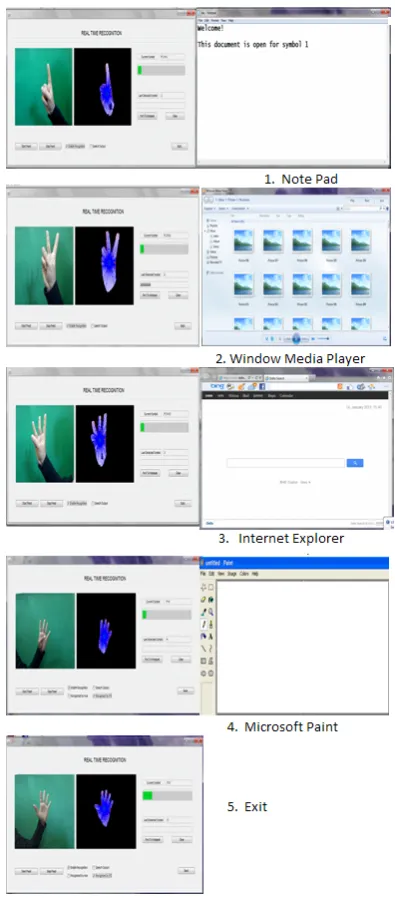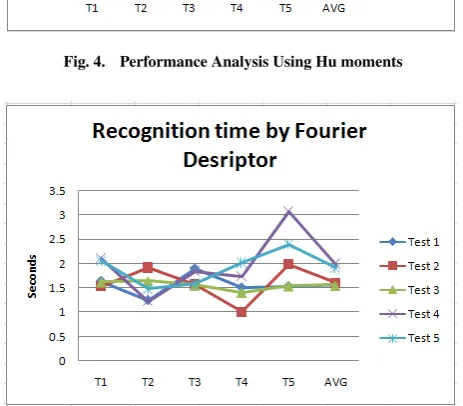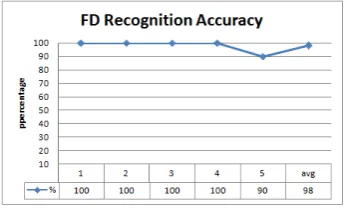Vision based Real Time Hand Gesture Recognition
Techniques for Human Computer Interaction
Archana S. Ghotkar
Pune Institute of Computer TechnologyUniversity of Pune Pune. (INDIA)
Gajanan K. Kharate, PhD.
Matoshri College Of Engineering and Research Centre University of Pune
Nashik. (INDIA)
ABSTRACT
Natural Interface with Computer using the intelligent approaches is the need of Human Computer Interaction (HCI)applications. In this paper, three techniques were proposed and experimented for interaction with Desktop/Laptop with static hand gesture. All these techniques were using real time approach with different feature descriptors such as Fourier Descriptor(FD),7 Hu moments, Convex Hull and Finger Detection. Real time Recognition efficiency was calculated with respect to recognition time for FD and 7 Hu moments. The 300 samples were trained and stored into database for recognition. For unknown user average recognition time was required 1.7 sec using FD as a feature and 4.6 sec using 7 Hu moments and recognition efficiency was achieved 96% and 98% using 7 Hu and FD respectively. In the second technique New Finger detection algorithm was developed and experimented with Hand tracking system(HTS). In this approach, system was working in dynamic background but gives better result in static background. In the third approach, 3-D Kinect camera was used where hand segmentation was achieved using depth image and finger detection were calculated using Convex Hull. In this approach hand seg-mentation became easier than first two techniques. With all these approaches feature extraction using 7 Hu and FD can be extend for any other HCI application including sign language recognition. Finger counting algorithm can be combined with other descriptor in complex hand sign as a feature. Currently system is working on static hand gestures, further it will be extended to dynamic hand gesture recognition for Indian sign language interpretation.
General Terms:
Hand Gesture Recognition, Hand segmentation, Hand tracking.
Keywords:
Human Computer Interface(HCI), Fourier Descriptor(FD), 7 Hu moments, Finger detection, Convex Hull.
1. INTRODUCTION
One of the objective of any HCI system is its natural interface. Among other human body part, hand gesture is most natural and powerful communication modality for interaction with computer which needs to be fully explored for HCI. There are two ma-jor approaches for hand gesture recognition: Data Glove, Vi-sion based. Each approach is having its limitation and advan-tages, but vision based approaches are more feasible as com-pared to data glove as user need not to wear cumbersome device like data glove.[1][2] Many researchers are working on Intelli-gent application of HCI such as IntelliIntelli-gent Homes/Offices[3],
Intelligent Games[4], Sign language recognition [5] and many more. Thomas and Jaron[6] developed hand-machine interface device that provides real-time gesture, position and orienta-tion informaorienta-tion. They used DataGlove containing flex sensors which measure finger blending, positioning and orientation sys-tems and tactile feedback vibrators. William Freeman and Craig Weissman[7] introduced Television control by hand gesture. In their system computer controls the television set through se-rial port commands. The user uses only one gesture: the open hand, facing the camera and he can control television by mov-ing hand. Interpretmov-ing human behavior to understand his cultural background is one of the applications of HCI. Matthiaset al.[8] introduced this application with major challenges such as grasp-ing culture as a computational term and inferrgrasp-ing the user´s cul-tural background by observable measures. Such an application can be interpreted of the standard language textbook to allow for a deeper understanding of the communication processes that could be achieved by just learning the grammar and words. Af-shinet al.[9] proposed algorithms and application for using hand as an Interface device in virtual and physical spaces. They pro-posed set of applications such as virtual drawing, 3-D model construction and 3-D virtual marble game with hand interface. Christian and Berard[10] described techniques for bare hand in-teraction with computer and tested on application such as con-trolling presentation with hand postures, paint virtually onto the wall.
With different applications of HCI, one of the application of Desktop/Laptop interaction with hand interface is chosen for experimentation of algorithms. Natural Interface is preferred to avoid traditional input devices such as keyboard and mouse is the state of the art of HCI application. The same application can be extended for the replacement of mouse by tracking mouse pointer with the tip of the hand finger. Here, five classes of static hand gestures are used for opening most frequently required win-dows applications in real time.
In the proposed work three techniques are explored using vision based approach. In the first technique FD and 7 Hu moments were used as a feature descriptor for recognition. In second tech-nique the new Finger Counting algorithm was developed and ex-perimented on HTS [12] system for the same application. Using Convex Hull method and 3D Kinect camera, third technique was explored for the same. The use of Kinect camera made this al-gorithm easy for pre-processing such as subtraction of complex background and skin color detection.
Fig. 1. Anticipated Data-set
Fig. 2. System Overview
2. DATA-SET
Design of data-set of any HCI application is the essential fac-tor as, it should posses naturalness and should not requires ex-tensive training to user and memorization of hand gestures. Considering these aspect anticipated data set was designed for its user friendliness interactive system. Figure (1) shows antici-pated gesture data set for the proposed system.
3. METHODOLOGY
The proposed algorithms were developed for static hand gesture recognition and tested for handling windows applications on Desktop/Laptop. Currently three techniques are proposed and experimented in real time. Vision based hand gesture recognition is having challenges such as variable lighting condition, dynamic background and skin color detection, considering theses fact algorithms were developed to overcome some of these chal-lenges. Recognition of hand gesture executes windows applica-tions such as opening Note pad, Windows media player, Inter-net explorer and MS-Paint. All algorithms were working on bare hand where user need not to wear any color gloves or data gloves.
Algorithm 1Algorithm for Training Sample Images Symbol DB =Set of SingleSymbol
SymbolMeanDB=Set of MeanSingleSymbol
SingleSymbol = ( SymbolData, FD[256], HuMoments[7]) 1: procedureTRAINSAMPLE.Finds Hu and FD components 2: fori←1, ndo . for n samples 3: TrainSingleSymb.HuMoments =
ExtractHuMo-ments(i) ;
4: TrainSingleSymb.FD = ExtractFD(i); 5: AddSymbolToDB(TrainSingleSymb); 6: end for
7: CalculateMeanDB(); .Calculate and store mean of each class
8: end procedure
3.1 Real Time Hand Gesture Recognition Algorithm using 7 Hu moments and Fourier Descriptor
This algorithm was developed for recognition of hand gesture in real time by keeping static background constraints for faster and accurate recognition. Feature extraction method such as
Fig. 3. Hand Gesture Recognition Using 7 Hu moments and FD
Algorithm 2Real-time Hand Gesture recognition using Hu mo-ments
1: procedureREALTIMEHU(ImageI) .Nearest Neighborhood Classification by 7 Hu descriptor
2: CurrentSymbol.HuMoments= ExtractHuMoments(I); 3: M = GetMeanSymbolList();
4: fori←1, M.lengthdo
5: ComputeEuclidianDist(CurrentSymbol,M[i]); 6: end for
[image:2.595.55.284.562.701.2]Algorithm 3Real-time Hand Gesture recognition using Fourier Descriptor
1: procedureREALTIMEFD(ImageI) .Nearest Neighbourhood Classification by Fourier descriptor 2: CurrentSymbol.FD= ExtractFD(I);
3: M = GetMeanSymbolList(); 4: fori←1, M.lengthdo
5: ComputeEuclidianDist(CurrentSymbol,M[i]) 6: end for
7: DetectedSymbol=GetMinimumDistanceSymbol() 8: end procedure
Fourier descriptor and 7 Hu moments were chosen as these meth-ods are invariant to translation, rotation and scale. Algorithm was trained on 300 samples and tested on five unknown users. Performance analysis was done considering recognition time required in real time situation for each class. Nearest neighbor-hood classification using Euclidean distance was used for recog-nition purpose. Figure (2) describes the system overview.
3.1.1 Pre-processing and Hand Segmentation. Real time im-age capturing was done with fixed size of 320x240. In pre-processing Gaussian blur and median filtering was applied for smoothing purpose and HSV [12] color space was used for skin color segmentation.
3.1.2 Feature Extraction. In the proposed algorithm features of the segmented hand gesture were calculated using Discrete Fourier transform(FD) [13] and 7 Hu moments[14] and stored in to the database for further processing. Algorithm (1) describes Training procedure for sample Images.
3.1.3 Recognition. Nearest Neighborhood approach was ap-plied for classification and recognition. Mean value of each class on training sample was calculated and stored for recognition purpose and compared with unknown user. Algorithm (2) and Algorithm (3) describes recognition process with Hu and FD descriptor. Performance analysis was done for both the descrip-tors in terms of accuracy and time required for recognition. The Recognition accuracy was calculated by Equation (1) where currently 10 sample test cases are considered for each class in real time. Equation (2) gives average accuracy of HCI system for total number of classes
accuracy(%) =CorrectClassif ication
T otalT ests ∗100 (1)
avg= n
X
i=1
accuracy
n (2)
where n is total number of classes.
[image:3.595.313.543.104.277.2]3.1.4 Experimental Results . The vision-based hand gesture recognition system also needs to meet the requirements including real-time performances, accuracy and robustness. Here, performance was measured in terms of time (in seconds). For static background with fixed distance(40 cm) from cam-era, 7 Hu moments and Fourier descriptor were giving 94% and 96% accuracy respectively. If signer distance is constant from camera, classification rate is increased. Figure (3) shows experi-mental results in real time. Figure (4) and Figure (5) shows per-formance analysis graph of recognition using Hu moments and FD respectively. In the graph five test cases are shown on five unknown users with recognition time required for each class. Average time required for hand gesture recognition using Fourier descriptor was 1.7 sec and using 7 Hu moments was 4.6 sec. Fig-ure (6) and FigFig-ure (7) shows recognition rate using 7 Hu and FD on 10 test cases for each class in real time.
[image:3.595.312.544.220.423.2]Fig. 4. Performance Analysis Using Hu moments
Fig. 5. Performance Analysis Using FD
3.2 Real time Hand Tracking and Recognition using New Finger Detection Algorithm
In this technique new algorithm was developed for count-ing number of fcount-inger raised. Here Hand trackcount-ing and segmentation(HTS)[12] had been developed under complex background for efficient bare hand segmentation and Finger count algorithm was experimented on segmented hand contour. Algorithm gave the total count of raised finger by analyzing seg-mented image. In this technique Contour image was scanned from left to right and right to left for detection of finger by ana-lyzing pixel value and finger count was interpreted. Based on fin-ger count value, respective application executed. Algorithm (4), Algorithm (5)and Algorithm (6) describes its working in detail. Figure (8) shows sample results of this algorithm.
Algorithm 4New Finger Counting algorithm
1: procedureNEWFINGERCOUNT(ImageI) .Detect Finger Count by scanning Contour image
2: Contour = HTS(I);
3: Height = GetHeight (Contour); 4: Width = GetWidth (Contour); 5: FingerCount = 0 ;
6: FingerCount=ScanLeftToRight(Contour) + ScanRight-ToLeft(Contour) -1;
Algorithm 5New Finger Counting-Left to Right Scan algorithm 1: procedureSCANLEFTTORIGHT(Contour).Detect Finger
Count by scanning Contour image from Left to Right 2: M inCheck= 999;
3: fori←0, Heightdo
4: forj←0, W idthdo
5: WhitePixel = FindXCordOfWhitePixel(); 6: ifW hiteP ixel <(M inCheck−30)then
7: FingerCount = FingerCount+1; 8: MinCheck = WhitePixel; 9: end if
10: j=j+ 1;
11: end for
12: i=i+ 1; 13: end for
14: end procedure
Algorithm 6New Finger Counting-Right to left Scan algorithm 1: procedureSCANRIGHTTOLEFT(Contour).Detect Finger
Count by scanning Contour image from Right to Left 2: M inCheck= 999;
3: fori←0, Heightdo
4: forj←W idth,0do
5: WhitePixel = FindXCordOfWhitePixel(); 6: ifW hiteP ixel >(M inCheck+ 30)then
7: FingerCount = FingerCount+1; 8: MinCheck = WhitePixel; 9: end if
10: j=j−1; 11: end for
12: i=i+ 1; 13: end for
[image:4.595.317.537.98.183.2]14: end procedure
[image:4.595.54.288.107.274.2]Fig. 6. Recognition accuracy Using 7 Hu moments
Fig. 7. Recognition accuracy Using FD moments
Fig. 8. New Finger Detection algorithm- sample results
3.3 Real time Hand Gesture Recognition using Kinect camera
In this approach Microsoft Kinect sensor 3D camera was used for hand recognition. Depth image was used for segmentation. Convex hull OpenCV function was used to detect number of defects(concavities) on hand and stored into the defect array. Based upon number of defects, finger count was determined.
3.3.0.1 Convex Hull. [17] Convex Hull is a region based structural method for shape representation. The prime objec-tive of using Convex Hull on segmented hand is to get convex deficiency of an image. Convex Hull need to be calculated by boundary tracing or using morphological operation. Polygon ap-proximation was used for extracting Convex Hull to reduce com-putational time. The extraction of convex hull found significant convex deficiencies along the boundary. The hand shape was rep-resented by a defect array of concavities. Algorithm (7) describes the working using convex Hull.
Algorithm 7Real-time Hand Gesture recognition using Kinect camera by Convex Hull
1: procedureFINGERDETECTIONBYKINECT(ImageI) . Finger Counting by Convex Hull
2: DepthImage = GetDepthRGBImage(I); 3: SmoothImage(DepthImage);
4: SegmentedImage = PerformThreashold(DepthImage ,OTSU Method)
5: Contour = GetContour(SegmentedImage); 6: Contour1 = ApproxPoly(Contour); 7: ConvexHull= GetConvexHull(Contour1);
8: Defect=GetConvexityDefects(Contour1,ConvexHull); 9: InterpretFingerCount(Defect);
10: end procedure
3.3.1 Experimental results. In vision based approach most of the work need to do on pre-processing such as, removing com-plex background, detecting skin color with simple two dimen-sional web camera. The main objective of using 3-D Kinect cam-era was to simplify the task of pre-processing by capturing depth image for hand segmentation.
Figure(9) shows Experimental Results using Convex Hull fea-ture on Kinect camera.
4. CONCLUSION AND FUTURE WORK
[image:4.595.49.284.108.640.2] [image:4.595.81.255.650.755.2]Fig. 9. Hand Gesture Recognition Using Kinect Camera
Table 1. Observations on working of three techniques
Algorithm Advantages and Limitations
FD,7 Hu features: Advantages:i)Invariant to rotation, translation and scale. ii)Applied to any complex sign.Limitations: i) Working on static background ii)Training data set is required . iii) Efficient classifier will required for large class of data.
Finger Detection: Advantages:i)Training Samples are not required. ii)Invariant to rotation, translation and scale. iii) Fast processing due to both side processing. Lim-itations:i)Only used for finger raised or vertical line count.
Convex Hull : Advantages:i)Use of 3 D camera simplified task of segmentation.
ii) Dynamic background subtraction.
iii) Convex Hull method gives accurate defect of hand shape. iv) Can be used for motion tracking and detec-tion.Limitations:i)Kinect camera is very sensitive so creates a problem for robustness. ii)Constant dis-tance is required to achieve accuracy.
where training data set is not required. Convex Hull method gives accurate defects of hand in real time, so raised finger can be eas-ily determined without training data set. The major objective of this work is to extend the work for sign language interpretation to aid deaf and dumb people. Currently system is working on static hand gesture and different features are generated and tested on different classes of hand gestures. The observation is that all al-gorithms are robust and accurate under static background and constant distance of camera and signer.
Table (1) discusses observations of all these techniques with its advantages and limitations. The different generated features such as 7 Hu moments, FD and count of raised finger could def-initely used for complex hand sign of sign language. In this paper nearest neighborhood classification using Euclidean dis-tance is developed for recognition but in future efficient clas-sification and recognition algorithm such as Navies Bayesian classification[18][19], support vector machine[20][21] [22] or Genetic algorithm[23] can be used for large class of data.
5. ACKNOWLEDGMENT
The authors are thankful to the Department of Science and Technology, Ministry of Science and Technology, New Delhi for supporting this non-commercial research under the Fast Track Scheme for Young Scientists (SR/FTP/ETA-18/08).
6. REFERENCES
[1] Noor Saliza,Jamilin Jais,”Hand Gesture Recognition using Hidden Markov Models:A Review on Techniques and Ap-proaches”,
[2] Pragati Garg,Naveen Aggarwal and Sanjeev So-fat, ”Vision based Hand GestureRecognition”, PWASET,Vol.37,pp.1024-1029,2009.
[3] S.Meyer and A.Rakotonirainy, ”A survey of research on context-aware homes”, Australasian Information Secu-rity Workshop Conference on ACSW Frontiers, pp. 159-168, 2003.
[4] K.Salen and E. Zimmerman,”Rules of Play : Game Design Fundamentals”, MIT press, Cambridge, 2003.
[5] Britta Bauer , Karl-Friedrich,”Towards an Automatic Sign Language Recognition System Using Subunits”, GW 2001,LNAI 2298, Springer-Verlag Berlin Heidelberg pp34-47,2002.
[6] Thomas G.Zimmerman, Jaron Lanier,”A Hand Gesture In-terface Device”, ACM-089791-213-6, pp. 189-192, 1987. [7] William T. Freeman and Craig D. Weissman,”Television
control by hand gestures”,
[8] Matthias Rehm, Nikolaus Bee, Elisabeth Andre”Wave Like an Egyptian- Accelerometer Based Gesture Recognition for Culture Specific Interactions”, British Computer Soci-ety,2007.
[9] Afshin Sepehri, Yaser Yacoob, Larry S. Davis”Employing the hand as n Interface Device”, Journal of Multimedia, Vol.1 No. 7, ,Academy Publisher,pp.18-29,2006.
[10] Christian von Hardenberg, Francois Berard,”Bare-Hand Human Computer Interaction”, Proceedings of the ACM Workshop on Perceptive User Interfaces, Orlando, Florida, USA, 2001.
[11] Elena Sanchez-Nielsen, Luis Anton-Canalis and Mario Hernandz-Tejera, ”Hand Gesture Recognition for Human Machine Interaction”, Journal of WSCG, Vol.12, No.1-3, ISSN 1213-6972, 2003.
[12] Archana S. Ghotkar , Gajanan K. Kharate,”Hand Segmen-tation Techniques to Hand Gesture Recognition for Natu-ral Human Computer Interaction”, International Journal of Human Computer Interaction(IJHCI), Computer Science Journal,Malaysia, Volume (3) : issue(1), pp.15-25.ISSN 2180 -1347,April 2012.
[13] Gang Zhang, Z.M..Ma, Ying He, Tienan Zhao,”Shape Feature Extraction Using Fourier Descriptors with Bright-ness in Content-based Medical Image Retrieval ”, Inter-national Conference on Intelligent Information Hiding and Multimedia Signal Pro- cessing, IEEE Computer Society, 2008.
[14] Yang Quan,Peng Jinye,Li Yulong”Chinese Sign Language Recognition Based on Gray Level Co-Occurrence Matrix and Other Multifeatures Fusion”, IEEE-ICIEA,pp.1569-1572,2009.
[15] Dengsheng Zhang,Cuojun Lu”Review of shape represen-tation and description techniques”, The Journal of The Pattern Recognition Society,Elsevier,pp1-19,2004.
[17] Anil K.Jain, Robert P.W.Duin,Mao, ”Statistical Pattern Recognition: A Review”, pp1-105,1999.
[18] Guo-Dong, Anil K. Jain,Wei-Ying Ma, Hong-Jiang Zhang, ”Learning similarity Measure for Natural Image Retrieval with Relevance Feedback”, IEEE Transactions on Neural Networks, Vol.13, No. 4, July 2002.pp. 811-820.
[19] Shu-fai Wong, Roberto Cipolla, ”Continuous gesture recognition using a sparse Bayesian classifier”, Interna-tional conference on pattern recognition, 2006.
[20] Luis Gonzalez, Cecilio Angulo, Franscisco, Juan Antonio Ortega,”A Probabilistic Tri-class Support Vector Machine”,
[21] Liu Yun, Zhang Peng”An Automatic Hand Gesture Recog-nition System based on viola-Jones Method and SVMS”, In-ternational workshop on Computer Science and Engineer-ing, IEEE Computer Society, 2009,pp. 72-76.
[22] David Mace ,Wei Gao, Ayse Coskun,”Improving Accu-racy and Practicality of Accelerometer Based Hand Gesture Recognition”, IUI,2013.



